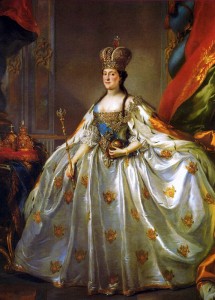Her reforms were progressive in the sense that they moved Russia towards modernization and brought the state in line with Western concepts of the relationship between a government and its subjects. One theme present throughout Catherine the Great’s reforms is an attempt to balance state powers and individual liberties. The Statute on Provincial Administration states that “the personal security of each loyal subject is quite precious to the Monarch’s philanthropic heart,” and the establishment of an ordered, hierarchical bureaucracy within the provinces is one way to enforce order and protect personal security among and of the subjects. However, the bureaucratization serves a second purpose, which is to quantify and order a population in case the state wishes to mobilize them when they need labor or combat. Article 20 of the Charter to the Nobility mandates that no subject may “spare neither labor nor even life itself in State service,” reminding the nobility that they are subject to the same calls to war and work as the rest of the population.
However, Catherine’s reforms also implement checks on state power. According to the Charter to the Towns, no urban corporation may make regulations contrary to the laws of the state. Catherine’s reforms standardized the rule of law throughout Russia and ensured that no provincial power could infringe upon the rights of their subjects by creating their own regulations. Overall, Catherine’s reforms show the delicate balance, characteristic of many nascent modern states, between using a population as a resource and respecting the rights of that population to encourage their obedience to their government.
Did Catherine’s reforms favor either the subject or the state?


